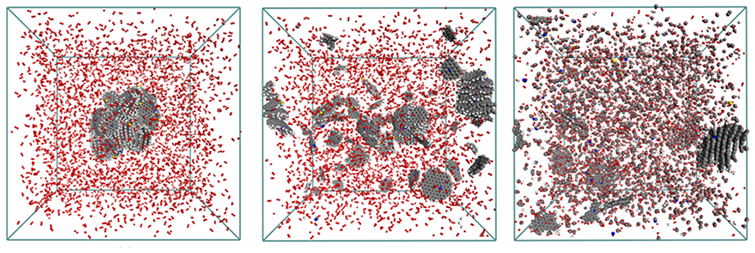Char combustion modeled with ReaxFF
Modeling the detailed chemical reaction dynamics of a complex system at the atomistic level is computationally too demanding for quantum-chemical methods and impossible with traditional force fields based on equilibrium properties. In the ReaxFF force field bond order potentials are employed with parameters fitted to quantum chemical data for reacting small molecules, so that the continuous bond forming and breaking processes in a chemical reaction can be described.
In a recent paper in Combustion and Flame, Castro-Marcano et al. simulated the combustion of a large devolatilized char (C5743H1511O131N61S12 + 14,000 O2) with ReaxFF to gain detailed insight in the structural evolution and the chemical reactions involved in high-temperature combustion. With ReaxFF 250 ps simulations of this >35,000 atoms system could be achieved on 36 quad-core processors within 6 weeks. The reactive MD study revealed complex initiation chemistry, with char oxidation typically initialized by either thermal degradation or by hydrogen abstraction reactions. A more rapid oxidation and combustion of polyaromatics occurred at fuel-lean conditions, while the thermal degradation pathway became more important at higher temperature.

ReaxFF reactive MD simulation of a combusting char structure (C5743H1511O131N61S12) surrounded by 14,000 O2 molecules at 3000 K (0 ps, 75 ps, and 250 ps). C: grey, H: white, O: red, N: blue, S: yellow.
ReaxFF, molecular dynamics, kinetics
F. Castro-Marcano, A. M. Kamat, M. F. Russo Jr., A. C. T. van Duin, J. P. Matthews, Combustion of an Illinois No. 6 coal char simulated using an atomistic char representation and the ReaxFF reactive force field Combustion and Flame, 159 (3), 1272-1285 (2012).
Key conceptsoil & gas Reactivity ReaxFF